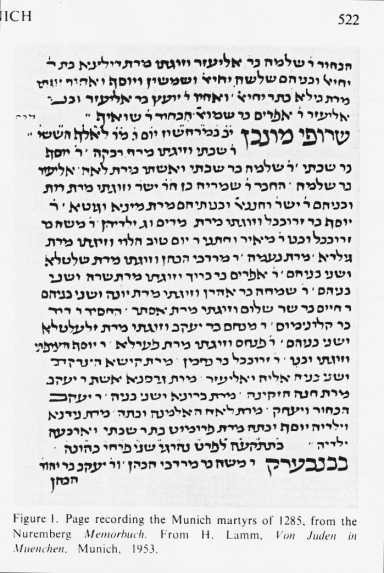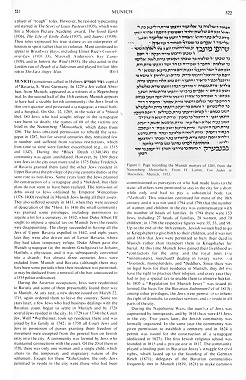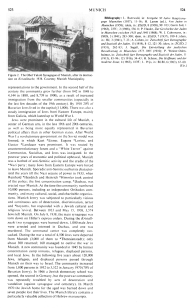| Teilen / share: |
Facebook |
|
Twitter
|
<MUNICH [[...]], capital of *Bavaria, S. West Germany.
[Blood libel in 1285 with burnt synagogue with 180 lethal victims]
In 1229 a Jew called Abraham, from Munich, appeared as a witness at a Regensburg trial. In the second half of the 13th century Munich appears to have had a sizable Jewish community; the Jews lived in their own quarter and possessed a synagogue, a ritual bath, and a hospital. On Oct. 12, 1285, in the wake of a *blood libel, 180 Jews who had sought refuge in the synagogue were burnt to death; the names of 68 of the victims are listed in the Nuremberg *Menorbuch, which dates from 1296.
Encyclopaedia Judaica (1971): Munich, vol. 12, col. 522, text about the burning of the synagogue with it's 180 lethal Jewish victims
[Rebuilding of the synagogue in 1287 but back and forth - expulsion from Munich in 1442 - expulsion from Lower Bavaria in 1450 - synagogue converted into a church]
The Jews obtained permission to rebuild the synagogue in 1287, but for several centuries they remained few in number and suffered from various restrictions, which from time to time were further exacerbated (e.g., in 1315 and 1347).
During the *Black Death (1348/49) the community was again annihilated. However, by 1369 there were Jews in the city once more and in 1375 Duke Frederick of Bavaria granted them (and the other Jews resident in Upper Bavaria) the privilege of paying customs duties at teh same rate as non-Jews. Some years later the Jews planned the construction of a synagogue and a *hekdesh [consecrated property for the temple], but their plans do not seem to ahve been realized. The remission of debts owed to Jews ordained by Emperor Wenceslaus (1378-1400) resulted in Munich Jews losing all their assets. they also suffered severely in 1413, when tehy were accused of desecration of the *Host. In 1416 the small community was granted some privileges, including permission to acquire a lot for a cemetery; in 1432, when Duke Albert III sought to impose a special tax on Munich Jews the results were disappointing. Teh clergy succeeded in having all the Jews of Upper Bavaria expelled in 1442, and eight years later they were also driven out of Lower Bavaria, where they had taken temporary refuge. Duke Albert gave the Munich synagogue (in the modern Gruftgasse) to Johann Hartlieb, a physician, and it was subsequently converted into a church. For almost three centuries Jews were excluded from Munich and Bavaria (although there may have been some periods when their residence was permitted, as may be deduced from a renewal of the ban announced in 1553 police ordinance).
[Bavaria as a part of Austria - expulsion decree in 1715 - only some special classes of Jews allowed - body tax]
During the Austrian occupation, Jews were readmitted to Bavaria and some of them presumably found their way to Munich. At any rate, a new decree issued on March 22, 1715, again ordered them to leave the country. some ten years later, a few Jews who had business dealings with the Bavarian count began to settle in Munich and by 1728 several Jews resided in the city. In 1729 (or 1734) the Court Jew, Wolf *Wertheimer, took up residence there and was joined by his family in 1742; in 1750 all Court Jews and Jews in possession of passes granting them freedom of movement were excepted from the general ban on Jewish entry into the city. A community was formed by Jews who maintained connections with the court. Of the 20 of them on 1750, there was only one woman and a single child, which attests to the temporary and migratory nature of the settlement. Except for these *Schutzjuden, the only Jews permitted to reside in the city were those who had been [col. 521]
commissioned as purveyors or who had made loans to the state; all others were permitted to stay in the city for a short while only and had to pay a substantial body tax (*Leibzoll). This situation continued for most of the 18th century and it was not until 1794 and 1798 that the number of women and children in the city was commensurate with the number of heads of families. In 1794 there were 153 Jews, including 27 heads of families, 28 women, and 70 children; in 1798 the respective figures were 35, 33, and 98.
[Circumstances at the end of 18th century for the few Jews in Munich]
Up to the end of the 18th century, Jewish women had to go to Kriegshaber to give birth to their children, and it was not until 1816 that Jews were permitted to bury their dead in Munich rather than transport them to Kriegshaber for burial.
At this time Munich Jews gained their livelihood as *contractors for the army and the royal mint (see *mintmasters), merchants dealing in luxury wares and *livestock, moneylenders, and *peddlers. Since there was no legal basis for their residence in Munich, they did not have the right to practice their religion, and every year they had to pay a special tax to enable them to observe Sukkot.
[More rights since 1805]
In 1805 a "Regulation for Munich Jewry" was issued (it formed the basis for the Bavarian Judenmatrikel of 1813); among other privileges, the Jews were permitted to inherit the right of domicile, to conduct services, and to reside in all parts of the city.
[Napoleon and struggle for civil rights - numbers]
During the Napoleonic Wars, the numbers of Jews was augmented by immigrants, and by 1814 there were 451 Jews in the city. Two years later, the Jewish community was formally organized. In the same year the community was given permission to establish a cemetery and in 1824 a permit was issued for the construction of a synagogue (dedicated in 1827). The first Jewish religious school was founded in 1815 and a private one in 1817. The community played a leading part in Bavarian Jewry's struggle for civil rights, which lasted up to the founding of the German Reich (1871); delegates of the Bavarian communities frequently met in Munich (1819, 1821) to make common [col. 522]
representations to the government. In the second half of the century the community grew further (from 842 in 1848 ton 4,144 in 1880, and 8,739 in 1900), as a result of increased immigration from the smaller communities (especially in the last few decades of the 19th century).
By 1910 20% of the Bavarian Jews lived in the capital (11,000). There was also a steady immigration of Jews from eastern Europe [[because of discrimination there]], mainly from Galicia, which lasted up to World War I.
Jews were prominent in the cultural life of Munich, a center of German arts, in the late 19th and 20th centuries, as well as being more equally represented in Bavarian political affairs than in other German states.
[[Happenings of World War I are not mentioned in this article, but they are very important: After WW I there was a big propaganda instigated by France to split Germany into Prussia and Bavaria and more little states which provoked strong nationalism in Bavaria and Prussia. Add to this Austria was forbidden to be member of Germany which provoked even more fury in Bavaria]].
[Jewish Communist government in Munich in 1919]
After World War I a revolutionary [[Communist]] government on the Soviet model was formed, in which Kurt *Eisner, Eugene *Levine, and Gustav *Landauer were prominent. It was routed by counterrevolutionary forces and a "White Terror" against Communists, Socialists, and Jews was instigated.
[[For the national German propaganda it was now easy to claim that every Jew would be a "Communist", but many Jews had also to suffer under Communism, and this was never said...]]
[Munich 1920-1933]
In the postwar years of economic and political upheaval, Munich was a hotbed of anti-Semitic activity and the cradle of the *Nazi party;
[[This was logic because of the Jewish Communist government which had been before in 1919. Any other town's population would have had the same reaction. The Communists had whole districts and whole towns in their hands, and the nationalists began to fight against the Communist spider which was also financed by the criminal "USA" by it's lodge connections. Until the stock exchange crash of 1929 the Nazi party was not more than a splinter of under 5% in Germany, in Bavaria maybe 10%]].
many Jews from eastern Europe were forced to leave Munich.
[[The Jews from eastern Europe had another culture than the Jews of western Europe and often were not helped by their Jewish brethren - so it seems having been in Munich. The cause of the migration movement - the discrimination of the Jews in eastern Europe because of the cut economic connections because of the new borderlines and the closed borderline with Communist Russia - was not eliminated, and by this the Jewish migration from eastern Europe went on]].
[Third Reich in Munich: concentration camp Dachau]
Sporadic anti-Semitic outbursts characterized the years till the Nazi seizure of power in 1933,
[[These anti-Semitic outbursts always were on the base that there had been a Jewish Communist government in 1919. Since the stock exchange crash of 1929 and the high unemployment the NSDAP got more and more popular because the Germans without work said that racism was not so important, but work was important. NSDAP gangs were murdering around and the German police was not capable to stop this violence, and was not capable to put Hitler into prison as a criminal foreigner, because Hitler got much money also from abroad. One has to consider that the NSDAP never got a majority in Germany but was given the power in 1933 because the Catholic Center party was in coalition with the racist NSDAP - because a coalition with the Communists was not at all possible]].
when Reinhold *Heydrich and Heinrich *Himmler took control of the police; the first concentration camp, *Dachau, was erected near Munich. At the time the community numbered 10,000 persons, including an independent Orthodox community, and many cultural, social, and charitable organizations.
[Jewish culture - Jewish emigration wave from Munich - destruction of synagogues in 1938 - arrests]
Munich Jewry was subjected to particularly vicious and continuous acts of desecration, discrimination, terror and *boycotts, but responded with a Jewish cultural and religious revival. Between 1933 and May 15, 1938, 3,574 Jews left Munich.
[[About details of the organization of the emigration wave, see: *Germany]].
On July 8, 1938, the main synagogue was torn down on Hitler's express orders. During the Kristallnacht two synagogues were burned down, 1,000 male Jews were arrested and interned in Dachau, and one was murdered. The communal center was completely ransacked.
[[A scale of discriminations of the Jews in Nazi Germany after 1939 is mentioned here, see: *Cologne]].
[Munich during World War II 1939-1945]
During the war a total of 4,500 Jews were deported from Munich (3,000 of them to *Theresienstadt); only about 300 returned; 160 managed to outlive the war in Munich.
[[Changing religion and changing name by forged identity papers is not mentioned in this article. Many Jews were not counted as Jews any more after 1945 and got lost in the statistics, so. And many may have emigrated directly]].
[Munich 1945-1970]
A new community was founded in 1945 by former concentration camp inmates, refugees, displaced persons, and local Jews. In the following five years about 120,000 Jews, refugees, and displaced persons passed through Munich on their way to [[racist Zionist Free Mason CIA Herzl]] Israel.
[[Munich was the center of the "American" Zone and was the center of the Displaced Persons in Germany. The D.P.s did emigrate not only to racist Zionist Free Mason CIA Herzl Israel, but in many cases also to the criminal "USA" which had financed the Third Reich and the "Soviet Union" at the same time, see: *Displaced Persons, and: D.P.s in *Germany and in *Vienna]
The community increased from 1,800 persons in 1952 to 3,522 in January 1970 (70% of Bavarian Jewry).
In 1966 a Jewish elementary school was opened, the second in Germany, but the post war community was repeatedly troubled by acts of desecration and vandalism (against synagogue and cemetery).
In March 1970 the Jewish home for the aged was burned down and seven people lost their lives. The Munich library contains a particularly valuable collection of Hebrew manuscripts. (col. 523)
[[It seems that the fury of the nationalists after the second big defeat of Germany could not be stopped, above all not since the Jew Philip Auerbach had abused public money for his pockets which was foreseen for Jewish reconstruction. Justice punished him and the case fed anti-Jewish prejudices. Further on there was the national leader Franz Joseph Strauss of CSU who was always again and again visiting his German Nazi friends in Chile who had fled there in 1944-1945. Strauss was one of the big mental illnesses of Bavaria after 1945: He could organize work and turned Bavaria into an industrial plant with BMW and supported the European Airbus project, but he also was polemic rightist and was an aggressive model for politics. By this he blocked the heads of many Bavarians...]]
| Teilen / share: |
Facebook |
|
Twitter
|
Bibliography
-- L. Baerwald, in: Festgabe 50 Jahre Hauptsynagoge Muenchen [[Festival 50 Years Main Synagogue of Munich]] (1937), 11-16
-- H. Lamm (ed.): Von Juden in Muenchen [[About Jews in Munich]] (1958)
-- idem, in: ZGJD, 8 (1938), 99-103
-- Germ Jud, 1 (1963), 237-238; 2 (1968), 556-8
-- P. Hauke: Zur Geschichte der Juden in Muenchen zwischen 1933 und 1945 [[About History of the Jews in Munich between 1933-1945]] (1968)
-- W.J. Cahnmann, in: JSOS, 3 (1941), 283-300
-- idem, in: ZGJD, 7 (1937), 180-8
-- idem, in: JH, 3 (1941), 7-23
-- A. Cohen, in: Zeitschrift fuer Demographie und Statistik der Juden [[Review for Demography and Statistics of the Jews]], 15 (1919), 8-12, 121-30
-- idem, in: ZGJD, 2 (1931), 262-83
-- J. Segall: Die Entwicklung der juedischen Bevoelkerung in Muenchen 1875-1905 [[Development of the Jewish Population in Munich 1875-1905]] (1910)
-- P. Weiner-Odenheimer, in: Zeitschrift fuer Demographie und Statistik der Juden [[Review for Demography and Statistics of the Jews]], 11 (1915), 85-96; 12 (1916), 34-43
-- H. Schnee: Die Hoffinanz und der moderne Staat [[The Court Finance and the Modern State]], 4 (1963), 187 ff.
-- L. Prijs, in: BLBI, 6 (1963), 67-80.
[ED.]> (col. 524)
Sources
Encyclopaedia Judaica (1971): Munich, vol. 12, col. 521-522
Encyclopaedia Judaica (1971): Munich, vol. 12, col. 523-524
^
![Encyclopaedia Judaica (1971): Munich, vol. 12,
col. 523. The Ohel Yakob Synagogue of Munich, after
its destruction on Kristallnacht [[Chrystal Night]],
1938. Courtesy Munich Municipality Encyclopaedia Judaica (1971): Munich, vol. 12,
col. 523. The Ohel Yakob Synagogue of Munich, after
its destruction on Kristallnacht [[Chrystal Night]],
1938. Courtesy Munich Municipality](EncJud_juden-in-Muenchen-d/EncJud_Munich-band12-kolonne523-Ohel-Yakob-syn-ruine1938-45pr.jpg)


